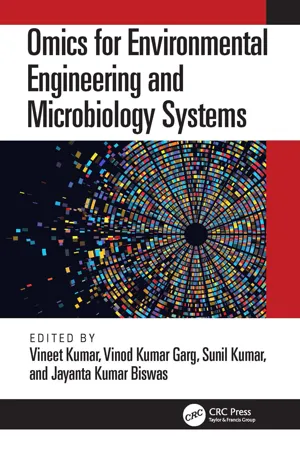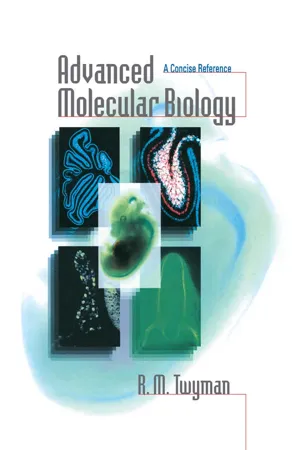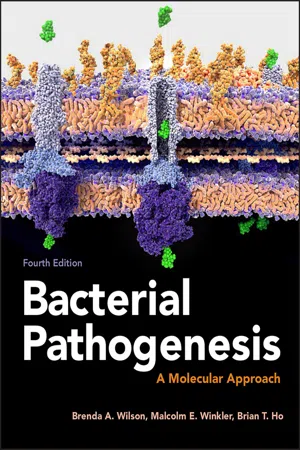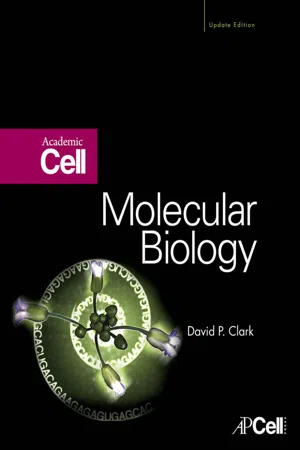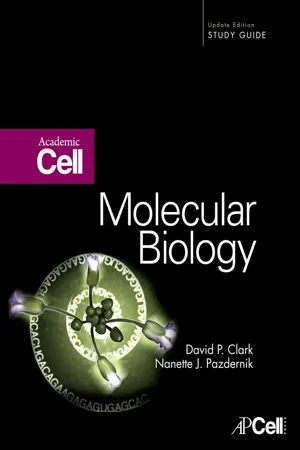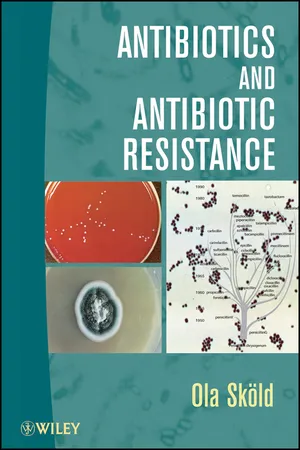Biological Sciences
Bacterial Transduction
Bacterial transduction is a process by which bacterial DNA is transferred from one bacterium to another by a bacteriophage, a type of virus that infects bacteria. During transduction, the bacteriophage mistakenly incorporates bacterial DNA into its own viral particles, which are then transferred to another bacterium upon infection. This mechanism allows for the exchange of genetic material between bacteria.
Written by Perlego with AI-assistance
Related key terms
Related key terms
1 of 4
Related key terms
1 of 3
7 Key excerpts on "Bacterial Transduction"
- Vineet Kumar, Vinod Kumar Garg, Sunil Kumar, Jayanta Kumar Biswas, Vineet Kumar, Vinod Kumar Garg, Sunil Kumar, Jayanta Kumar Biswas(Authors)
- 2022(Publication Date)
- CRC Press(Publisher)
Yaffe et al., 2020 ).22.2.1.3 Transduction
Transduction is the transfer of genetic material among bacteria through and intermediate virus such as a bacteriophage. Transduction mechanisms’ types are generalized and specialized transductions. When in lytic cycle, a bacteriophage incorporates segments of host bacterial genome during capsid synthesis and it is called generalized transduction. In contrast, specialized transduction is characterized by excision and packaging of nearby regions flanking the integration site of a lysogenic phage in a capsid. In lateral transduction, prophages commence DNA replication being integrated with the host genome. The human gut is a breeding spot for a vast community of bacteriophages carrying significant amount of ARGs. The bacteriophage-harbouring ARGs are also present in other natural environments. The overflow of the phages carrying ARGs in human gut surges upon antibiotic consumption. Experiments suggest that transduction might contribute to the development of drug resistance in gut-colonizing E. coli strains and other gut bacteria (Ross et al., 2015 ).22.2.1.4 Conjugation
MGEs such as plasmids and transposons are transferred during conjugation from one bacteria to another. Plasmids are proven to be the most pertinent for the dissemination of ARGs among MGEs class, as they possess multiple resistance genes because of their considerable size (~ 90 kbp). In addition, plasmids often carry other genes that contribute to bacterial fitness (resistance genes to disinfectants or heavy metals). ARGs henceforth are often co-selected under environmental pressure, since they inhabit genetically with other fitness determinants. Nevertheless, plasmids may provide mechanisms permitting the mobilization of DNA, thus highly boosting the potential for HGT of resistance genes (Bickhart et al., 2019- eBook - ePub
Advanced Molecular Biology
A Concise Reference
- Richard Twyman(Author)
- 2018(Publication Date)
- Garland Science(Publisher)
Chapter 10Gene Transfer in Bacteria
Fundamental concepts and definitions- Gene transfer describes the introduction of genetic information into a cell from an exogenous source (ultimately, another cell). This process occurs naturally in both bacteria and eukaryotes, and may be termed horizontal or lateral genetic transmission to distinguish it from the transmission of genetic information from parent to offspring, which is vertical genetic transmission.
- Intraspecific gene transfer facilitates genetic mixing in asexual species and thus mimics the effects of sexual reproduction. Such parasexual exchange mechanisms have been exploited to map prokaryote genomes analogously to meiotic mapping (q.v.) in eukaryotes. Interspecific gene transfer can also occur, and is a natural mechanism of transgenesis (q.v.). Interspecific gene transfer is an important evolutionary process and has been responsible for some of the most fundamental evolutionary events (e.g. the endosymbiont origin of eukaryotic organelles) as well as facilitating specific interactions between bacteria and eukaryotes (e.g. tumor-induction by Agrobacterium tumorfaciens; q.v. Ti plasmid).
- The source of the transferred information is the donor and the genetic information transferred is the exogenote (exogenous genome, usually only a fragment of the donor genome). The target of the gene transfer, the recipient, possesses the endogenote (endogenous genome). If the exogenote is homologous to part of the endogenote, gene transfer will make the recipient cell partially diploid (a merozygote), in which case recombination can occur, which may involve allele replacement (marker exchange).
- There are four major mechanisms of gene transfer in bacteria: cell fusion, conjugation, transformation and transduction (Table 10.1 ).
- eBook - ePub
ASM Books
A Molecular Approach
- Brenda A. Wilson, Malcolm Winkler, Brian T. Ho(Authors)
- 2019(Publication Date)
- ASM Press(Publisher)
7 IN THIS CHAPTER Adapt or Perish Acquiring New Virulence Traits by Horizontal Gene Transfer Mechanisms of Genetic Change and Diversification Spontaneous Mutation Phase Variation Antigenic Variation Horizontal Gene Transfer: Mobile Genetic Elements Natural Transformation Conjugation: Plasmids and Transposons Phage Transduction Control of Horizontal Gene Transfer Toxin-Antitoxin Systems—Retaining the GoodsRestriction-Modification Systems — Bacterial Innate Immunity from Foreign DNACRISPR-Cas Systems—Bacterial Adaptive Immunity from Foreign DNA Type 6 Secretion Systems—Bacterial Defense Against Conjugation Pathogenicity Islands and Pathogen Evolution Properties of Pathogenicity Islands Pathogen Evolution in Quantum Leaps Selected Readings Questions Solving Problems in Bacterial Pathogenesis CHAPTER 7 Mechanisms of Genetic Modification and Exchange ROLE IN PATHOGEN EVOLUTIONImagine kissing someone and acquiring from that person a whole new chromosome, which gives you features of the person you kissed. Sound like a far-fetched science fiction scenario? For humans it is, but it is actually quite commonplace among microbes. Bacteria routinely undergo a process called conjugation, in which two bacterial cells engage in close contact with each other as one transfers segments of DNA into the other. These DNA segments can be extremely large, even hundreds of kilobases, accounting for as much as one-third of some bacterial chromosomes. Of course, the DNA segments that are typically transferred are much smaller than this, but most still carry multiple genes. This process is one of a group of processes collectively referred to as horizontal gene transfer. Incredibly enough, most of the time, these large additions of DNA are well tolerated and can grant the bacteria powerful new traits such as resistance to antibiotics, the ability to utilize new nutrient sources, or new abilities to cause disease. Additionally, many of these bacterial gene transfers occur across species and genus lines. It might be pure science fiction when Peter Parker became Spiderman after being bitten by a spider, but that is essentially what happens all the time in the bacterial world. - eBook - ePub
Recombinant DNA and Genetic Experimentation
Proceedings of a Conference on Recombinant DNA, Jointly Organised by the Committee on Genetic Experimentation (COGENE) and the Royal Society of London, Held at Wye College, Kent, UK, 1-4 April, 1979
- Joan Morgan, W. J. Whelan(Authors)
- 2013(Publication Date)
- Pergamon(Publisher)
in vivo manipulations is that the genes to be fused must be present in the same cell. If genes belonging to different strains have to be operated upon, they must be first brought together in the same cell. This is done relatively easily between fairly different bacterial strains, often classified under different generic names. Mutagenic treatments usually have no genetic specificity, in the sense that they attack equally strongly different regions of the exposed chromosomes. One consequence of this is that with powerful mutagenic treatments, one runs the risk of introducing a number of different mutations in the same chromosome. This can be avoided by applying another selective technique, localized mutagenesis.As part of the general theme of this session, I am expected to review the classical, that is, in vivo genetic manipulations of organisms that have developed over the years. I assume a genetic manipulation to be something more advanced or more complicated than an ordinary cross or hybridization. Since I am a microbial geneticist, and Escherichia coli with its viruses and plasmids is the organism known in the finest detail from the genetic point of view, I will limit my considerations to bacteria.I will first recall some features of E. coli genetics that seem to apply to numerous other bacterial types.All known types of recombination in bacteria are directional, in the sense that one can always recognize a donor and a recipient organism, and that only a part, often a very small part, of the total genome is transferred. Exceptions are some experimentally contrived cell fusions in Bacillus (Schaeffer and co-workers, 1976; Fodor and Alfoldi, 1976 ).The transfer may be simply the uptake by a bacterium of a piece of DNA set free through the disintegration of another bacterium, followed by integration within the recipient’s chromosome. This is called transformation. It occurs naturally in certain types of bacteria, which have even developed special and to some extent specific mechanisms for the uptake (Raina, Metzer and Ravin, 1978 ). In many other types of bacteria it can be produced artificially by treating the recipient with high concentrations of calcium, or by stripping the bacterium of its cell wall.The transfer may occur via a virus, a bacteriophage, of the not fully virulent kind, particularly those that are able to establish lysogeny, the so-called temperate bacteriophages. Their DNA can implant itself in the infected bacterium without killing the latter and replicate with it.The DNA of the virus can be found in the bacterium as an autonomously replicating DNA ring. This is the case for the phages of the P1 class. At some later stage the phage DNA may be incorporated into newly made virus particles. As a byproduct of this process, it happens that equally large fragments of DNA of the host bacterium also become packaged in mock virus particles. These particles will infect other bacteria, and will deliver to the new recipient the DNA fragment of the bacterium in which they were formed. Integration of the fragment into the chromosome of the recipient will produce a permanent genetic change in the latter. - eBook - ePub
- David P. Clark(Author)
- 2009(Publication Date)
- Academic Cell(Publisher)
When a virus succeeds in infecting a bacterial cell it manufactures more virus particles, each of which should contain a new copy of the virus genome. Occasionally, viruses make mistakes in packaging DNA, and fragments of bacterial DNA get packaged into the virus particle. From the viewpoint of the virus, this results in a defective particle. Nonetheless, such a virus particle, carrying bacterial DNA, may infect another bacterial cell. If so, instead of injecting viral genes, it injects DNA from the previous bacterial victim. This mode of gene transfer is known as transduction.Viruses may pick up fragments of host DNA and carry them to another host cell.Bacterial geneticists routinely carry out gene transfer between different but related strains of bacteria by transduction using bacterial viruses, or bacteriophages (phages for short). If the bacterial strains are closely related the incoming DNA is accepted as “friendly” and is not destroyed by restriction. In practice, transduction is the simplest way to replace a few genes of one bacterial strain with those of a close relative.To perform transduction, a bacteriophage is grown on a culture of the donor bacterial strain. These bacteria are destroyed by the phage, leaving behind only DNA fragments that carry some of their genes and are packaged inside phage particles. If required, this phage sample can be stored in the fridge for weeks or months before use. Later, the phage are mixed with a recipient bacterial strain and the DNA is injected. Most recipients get genuine phage DNA and are killed. However, others get donor bacterial DNA and are successfully transduced (Fig. 18.08 ).Figure 18.08 Principle of TransductionOccasionally, when a phage infects a bacterium, one of the virus coats will be packaged with host bacterial DNA. The defective phage particle still infects a nearby cell where it injects the bacterial DNA. This cell will survive since it is not injected with viral DNA. The incoming DNA may be recombined with the host chromosome, thus this cell may gain new genetic information.Generalized Transduction
There are two distinct types of transduction. In generalized transduction fragments of bacterial DNA are packaged more or less at random in the phage particles. This is the case for bacteriophage P1 as described above (Fig. 18.08 ). Consequently all genes have roughly the same chance of being transferred. In specialized transduction - eBook - ePub
Molecular Biology
Academic Cell Update Edition
- David P. Clark(Author)
- 2012(Publication Date)
- Academic Cell(Publisher)
In the second type of genetic exchange, bacteria can get new genes from viruses in a process called transduction. Here a virus infects one bacterium, and when it packages all its progeny, occasionally, a piece of bacterial chromosome is packaged in the phage head rather than the viral genome. This phage can infect another host cell where it will inject its piece of chromosomal DNA rather than the viral genome. Although the chromosomal DNA is linear, if it has any homology with the new host chromosome, recombination can integrate the new DNA into the recipient cell, changing the genome permanently. In the laboratory, any bacteria that gets phage genome is killed by lysis, and all those cells that get the defective phage will survive and divide as usual.Transduction can be generalized or specialized. In generalized transduction, fragments of bacterial DNA are packaged at random in the phage particles, as seen in P1 phage and P22 phage. In order to get bacterial DNA into a viral coat, the virus must not degrade the host DNA during infection. Most of all, headful packaging is essential because these phage particles only need a certain amount of DNA, not a certain DNA sequence for packaging to occur. In specialized transduction, certain regions of bacterial DNA are carried along with the viral genome. One example of specialized transduction occurs when X prophage incorrectly excises from the bacterial chromosome. When it is incorrectly removed, a small region of the flanking bacterial chromosome may also be packaged in the phage. The two genes around the attC site, gal and bio , are usually all that can be packaged, and some λ genes are lost to include the bacterial DNA. When λ packages the gal gene (λ dgal) , the phage cannot make head or tail components, and when λ packages the bio gene (λpbio) , the virus lacks the int - eBook - ePub
- Ola Sköld(Author)
- 2011(Publication Date)
- Wiley(Publisher)
Chapter 10 Mechanisms for the Horizontal Spread of Antibiotic Resistance Among BacteriaIn this chapter we describe how pathogenic bacteria can acquire genes that mediate antibiotic resistance and how these genes can spread between bacteria by many different genetic transport mechanisms. There is also a short description of antibiotic resistance by spontaneous mutations.Transferable resistance: conjugationIn earlier chapters we mentioned that resistance to several antibacterial agents can spread horizontally from bacterium to bacterium, and even promiscuously, in the sense that transfer can also take place between bacterial species. The property of resistance must be represented in the bacterial genome; thus the transfer of resistance must include the transfer of DNA between bacteria, most commonly by the bacterial genetic phenomenon of conjugation (Fig. 10.1 ). We should note that the particular study of antibiotic resistance and its spread in bacterial populations has played a seminal role in the development of recombinant DNA technology and its applications, and the study of plasmid-borne resistance has granted a very large benefit to basic molecular biological science in general. The transfer of antibiotic resistance between bacteria could be called contagious resistance , in that antibiotic-susceptible bacteria are infected with resistance genes. The mechanism of conjugation mentioned has the ability to transfer several resistance genes at the same time, contagious multiresistance .Figure 10.1 Bacterial conjugation. Conjugation between cells of E. coli as seen in an electron microscope. The pilus of the donor bacterium establishes a cell-to-cell contact between donor and recipient.That genetic material could be transferred between bacteria at cell contact was first observed in experiments with E. coli in 1946. Those first observations led to the discovery of the F factor (F for fertility), which turned out to be an extrachromosomal genetic element with the ability to transfer from one bacterial cell to another at cell contact. That the latter was essential was obvious from the fact that agitation and blending abolished the transfer. The F (for “fertility”) factor was also found to be able to induce the transfer of chromosomal genes from one cell to another, a kind of sexuality to form new gene combinations. For a more detailed description of this very important bacterial phenomenon, see textbooks on microbiology. The F factor is a circular DNA molecule, occurring in small numbers outside the large cellular, circular chromosome. At cell growth the F factor is replicated in phase with the chromosome. Extrachromosomal genetic elements such as the F factor, called plasmids , appear in many different forms in the bacterial world. With the F factor as an example, many other plasmids with the ability to transfer from bacterium to bacterium have been identified. This phenomenon of transfer, called conjugation , is effected by a proteinaceous fingerlike structure, a pilus, induced by the plasmid and located on the surface of the host bacterium. The pilus can establish contact with another bacterium (see Fig. 10.1
Index pages curate the most relevant extracts from our library of academic textbooks. They’ve been created using an in-house natural language model (NLM), each adding context and meaning to key research topics.
Explore more topic indexes
Explore more topic indexes
1 of 6
Explore more topic indexes
1 of 4
